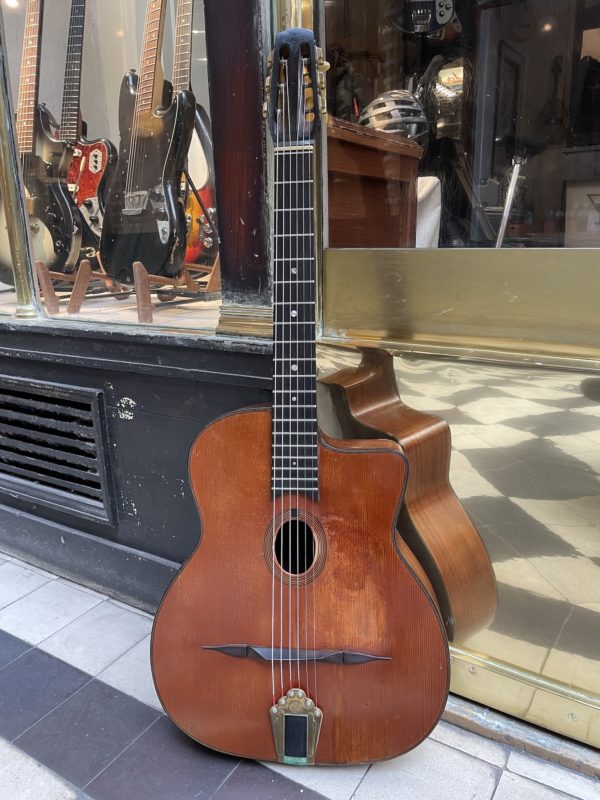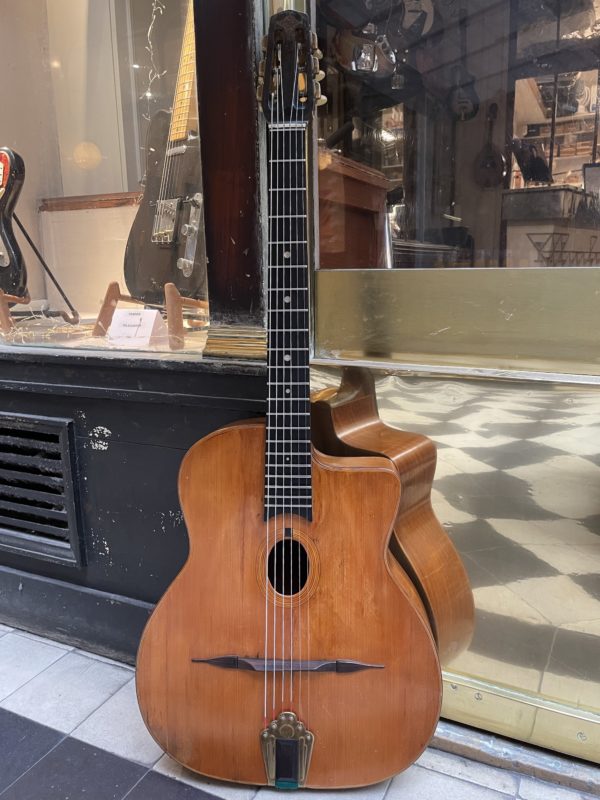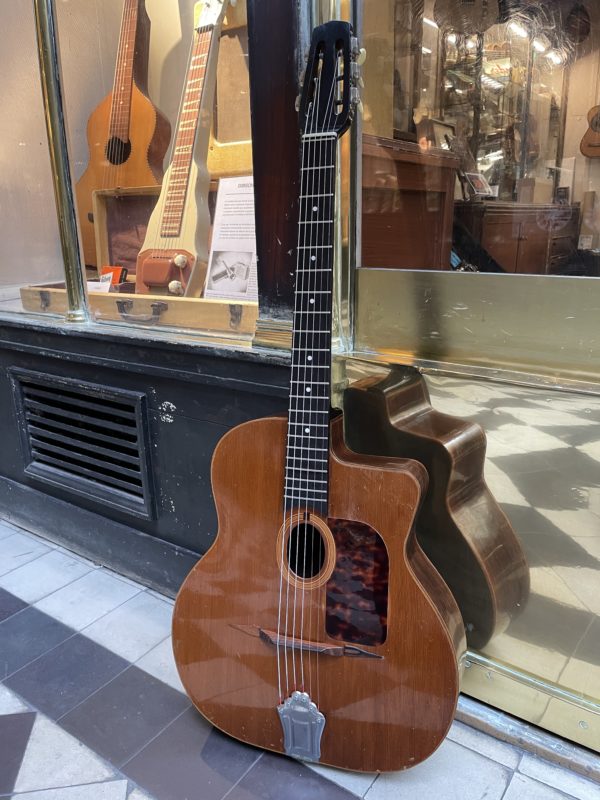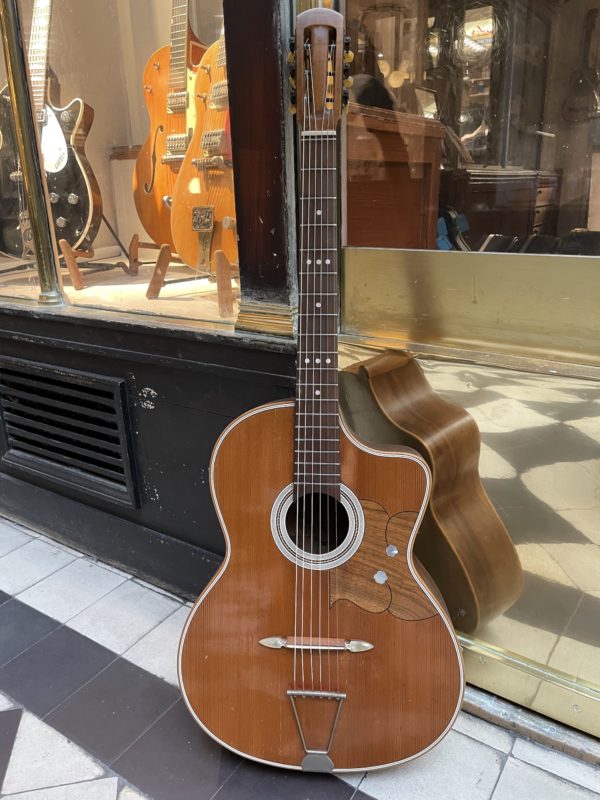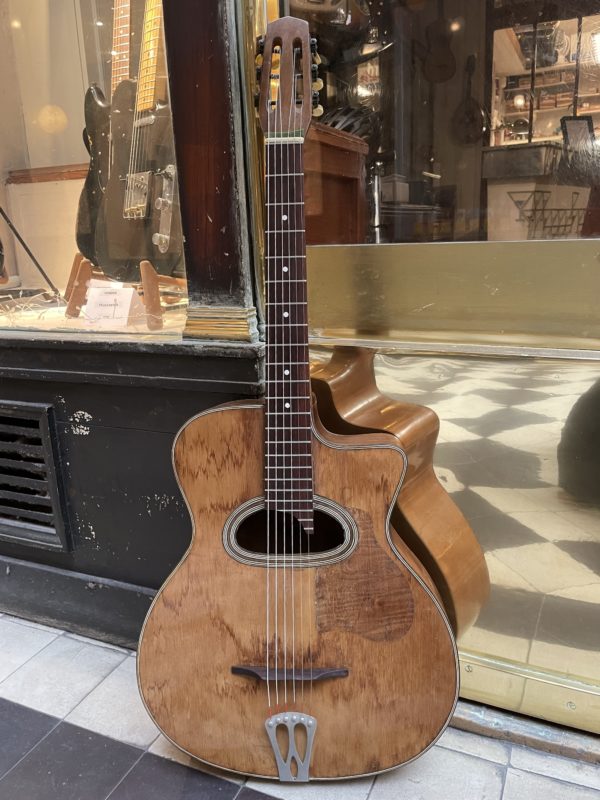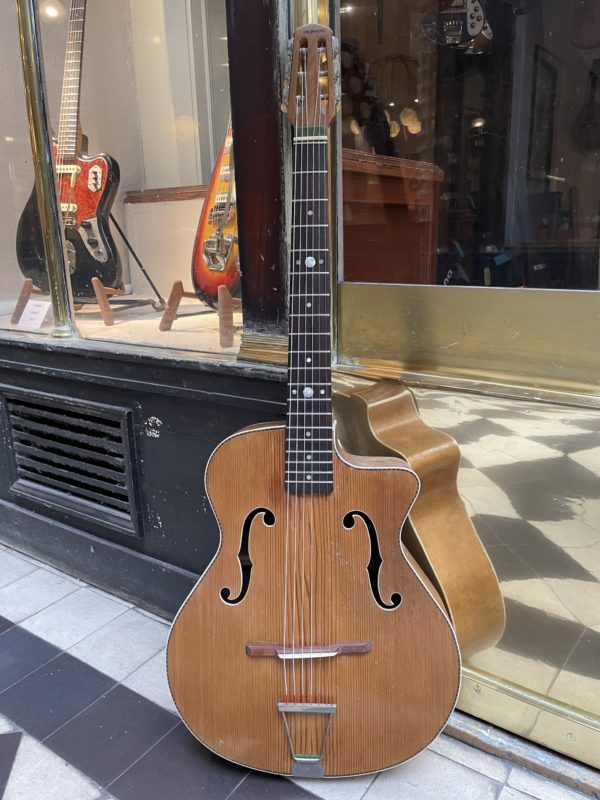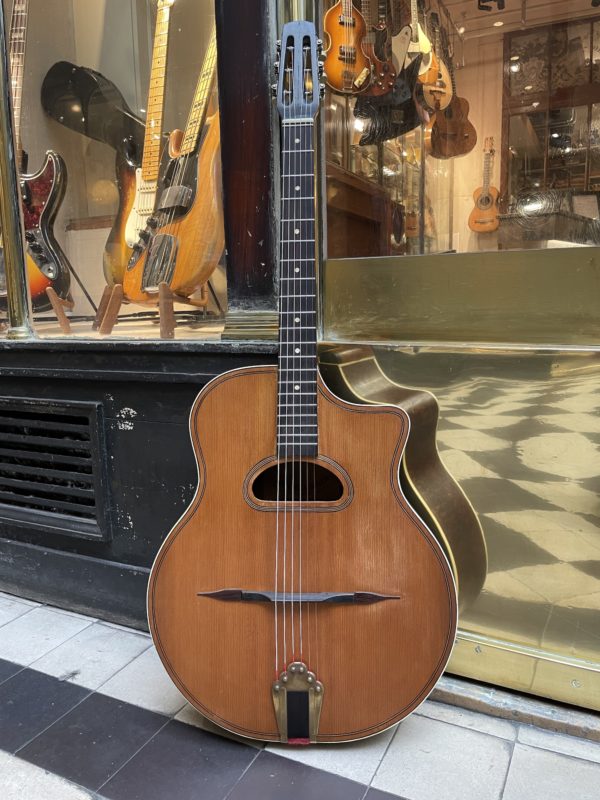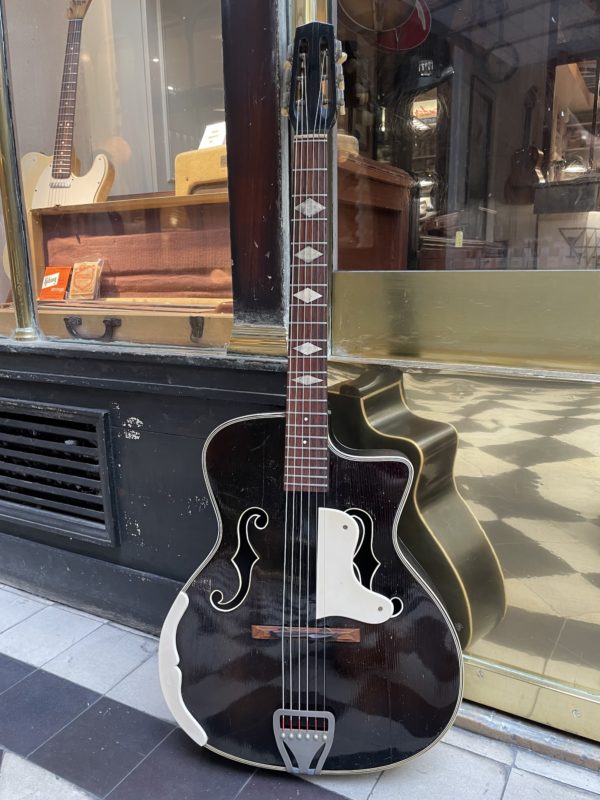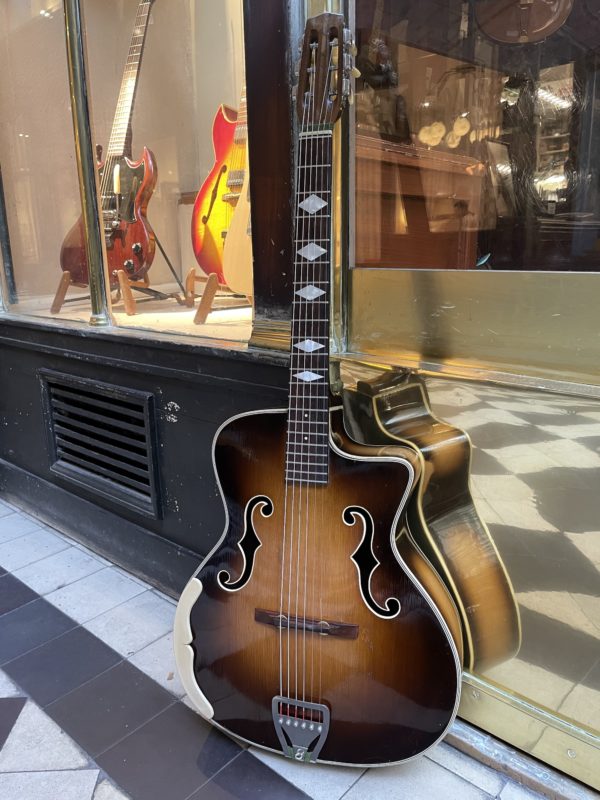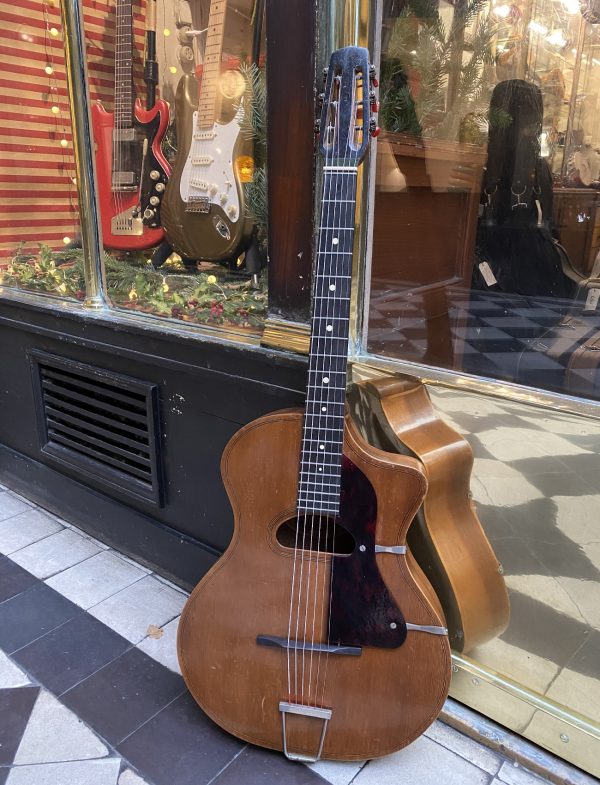Gypsy Jazz
THE GYPSY JAZZ GUITAR
France, early 1930s. After the long reign of the six-string banjo-guitar, a new breed of instrument would claim the spotlight in all of the musette and French jazz ballrooms, in the form of a very peculiar type of guitar which emerged from the great workshops of the likes of Selmer, already world-renowned at the time for their superior quality woodwind and brass instruments. Let us take a look at this true « Reine de la Musette » (sic) and the numerous imitators, some successful and others not so much, that followed suit.
In the 1920s, an entire generation of woodworkers would immigrate to France from all over Italy, mainly the Southern regions and Sicily. Some of them wished to distance themselves from increasingly restricting corporatism in their profession, many just wanted to flee the extreme poverty they were facing and the sudden infatuation with black shirts appearing all over the country. They were for the most part furniture makers or carpenters, although some were already skilled instrument builders at the time of their arrival in France, notably those coming from the ancient city of Catania, Sicily, where string instruments ranging from violins to mandolines had been produced for several generations, making it the hearth of Italian lutherie.
We could consider the city of Mirecourt, located in the Vosges mountain range, to be the French equivalent to Catania, in the sense that it concentrated most of the country’s production of quartet instruments, guitars, mandolins and banjos. This paradigm would be entirely revised with the entrance of the Italian makers in the 1920s, both geographically as they would mainly settle and set up businesses in large French cities, and in the way the knowledge of workmanship would be passed down, moving from the closed circuit of the Mirecourt workshops to a multitude of family businesses where skills were taught from one generation to the next. Thus, the period stretching from the 1920s to the 1990s for the most persistant could be described as the period of the « guitariers » (in French, « guitar makers »), indeed at the time the term « luthier » was exclusively reserved to quartet instrument makers. Among them, we find hallmark names such as Maccaferri, who initiated the movement with his innovative guitar design sold by Selmer, followed by Busato, Favino, Castelluccia, Pappalardo, Anastasio, Di Mauro, Bucolo, Grizzo, Siro & Gino and so on. They proved to be extremely skilled workers, and well able to react to the desires of the musicians of their time by offering rather rudimentary yet efficient guitars accessible at any price range. To this list we may like to add a few more names non-Italian makers just as prominent at the time, like Pierre Fontaine, David Enesa or Arthur Carbonell, based in Marseille. All of the builders have left their mark in the history of 20th century French lutherie and their work can be heard to this day in the string sounds of musette and gypsy jazz: not only were they tireless builders, whether working in corporations, under their own names or for larger distributors such as Paul Beuscher, they produced instruments in quantities that were second only to the output of American manufacturers, and were especially the initiators of a typically French culture bubble that was cast across the world thanks to the likes of Django Reinhard, imitated by many yet equalled by none. Thus, French gypsy-jazz guitars have become truly mythical instruments and are nowadays desired all over the globe.
As previously mentioned, the inception of the gypsy-jazz guitar as a whole stems from the inventive genius of a single man, Mario Maccaferri (1900-1993). This multi-talented genius, hailing from the city of Cento in Eastern Italy, was among the first wave of Italian luthiers to settle in France. He does however stand out among most of his blue-collar peers, in that prior to his arrival in France, he was a recognized violin and guitar builder – even holding several patents for his work -, a guitar teacher and world-renowned concertist, and a former student of Luigi Mozzani (1869-1943), himself a luthier and guitarist who would greatly inspire Maccaferri in his later work.
In 1931, the old Selmer house, specialized in brass and woodwind instruments since its foundation in 1900, unexpectedly approached Maccaferri and offered him a position to develop a range of guitars, including the then standard gut-stringed instruments as well as steel-stringed guitars oriented towards Hawaiian music and jazz, both of which were emerging around the same time. Indeed, Mario Maccaferri’s talent and inventiveness allowed Selmer’s production lines to open up their offer to the flourishing guitar market, however the man’s somewhat rigid mentality as well as conflicts regarding his contract with Selmer will cause the end of this relationship as early as 1934. This short-lived collaboration is somewhat reminiscent of Lloyd Loar, who had redefined the very concept of mandolin and guitar making while working for Gibson, before abruptly leaving the company for similar reasons. Despite Maccaferri’s departure, Selmer will continue producing guitars all the way up until 1952, around a single steel-stringed guitar model that was supposed to essentialize the concepts set out by Maccaferri. As to the man himself, having suffered a debilitating accident rendering him unable to play concert guitar any longer, he immigrated to the United States in the pre-war period and focused his creative power on a plethora of plastic guitars, ukuleles, violins, reeds and… clothespins (which he patented in 1947 under US Patent #US2429557A) – maybe thought up as a necessary accessory for musicians wishing to play sweaty, seedy basement sets and avoid olfactory agression?
Selmer’s first steel-stringed model « under the artistic direction of Mario Maccaferri » (sic) was the Orchestre model. Maccaferri drew his inspiration from the Neapolitan mandolin. Thus, the top of the Orchestre model is curved both in length and in width and held in place by bars glued on its underside. Other common traits shared with the mandolin are the large D-shaped hole in the top and the angled tailpiece attached along the length of the lower portion of the side. Most notably however, this model saw one of the earliest iterations of the cutaway – once again inspired by Luigi Mozzani’s work – increasing ease of access to the highest notes of the fretboard. In comparison, Gibson only started offering cutaway models in the post-war, making this feature the standard on American guitars. After the Maccaferri period, Selmer will go on to offer a revised model with new characteristics: in the place of the D-hole, a small oval-shaped rosette drawing directly from French romantic-period lutherie as well as a thinner, 14-fret neck instead of the previously 12-fret neck, thus bringing it closer to its contemporaries produced by Martin and Gibson. Despite a very similar general esthetic, Maccaferri Selmer guitars and later Selmer guitars are said to sound very different from one another. Maybe the answer to this controversial statement will be found among the recordings of Django Reinhardt, the one and only, who used both forms with great talent and to great effect!


